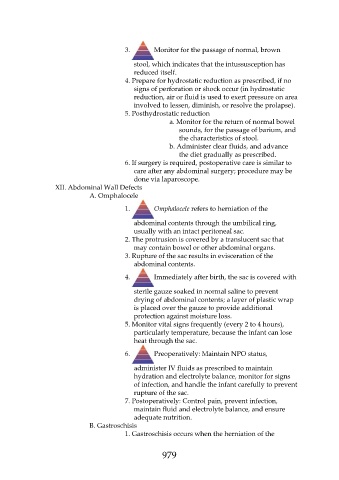Page 979 - Saunders Comprehensive Review For NCLEX-RN
P. 979
3. Monitor for the passage of normal, brown
stool, which indicates that the intussusception has
reduced itself.
4. Prepare for hydrostatic reduction as prescribed, if no
signs of perforation or shock occur (in hydrostatic
reduction, air or fluid is used to exert pressure on area
involved to lessen, diminish, or resolve the prolapse).
5. Posthydrostatic reduction
a. Monitor for the return of normal bowel
sounds, for the passage of barium, and
the characteristics of stool.
b. Administer clear fluids, and advance
the diet gradually as prescribed.
6. If surgery is required, postoperative care is similar to
care after any abdominal surgery; procedure may be
done via laparoscope.
XII. Abdominal Wall Defects
A. Omphalocele
1. Omphalocele refers to herniation of the
abdominal contents through the umbilical ring,
usually with an intact peritoneal sac.
2. The protrusion is covered by a translucent sac that
may contain bowel or other abdominal organs.
3. Rupture of the sac results in evisceration of the
abdominal contents.
4. Immediately after birth, the sac is covered with
sterile gauze soaked in normal saline to prevent
drying of abdominal contents; a layer of plastic wrap
is placed over the gauze to provide additional
protection against moisture loss.
5. Monitor vital signs frequently (every 2 to 4 hours),
particularly temperature, because the infant can lose
heat through the sac.
6. Preoperatively: Maintain NPO status,
administer IV fluids as prescribed to maintain
hydration and electrolyte balance, monitor for signs
of infection, and handle the infant carefully to prevent
rupture of the sac.
7. Postoperatively: Control pain, prevent infection,
maintain fluid and electrolyte balance, and ensure
adequate nutrition.
B. Gastroschisis
1. Gastroschisis occurs when the herniation of the
979

